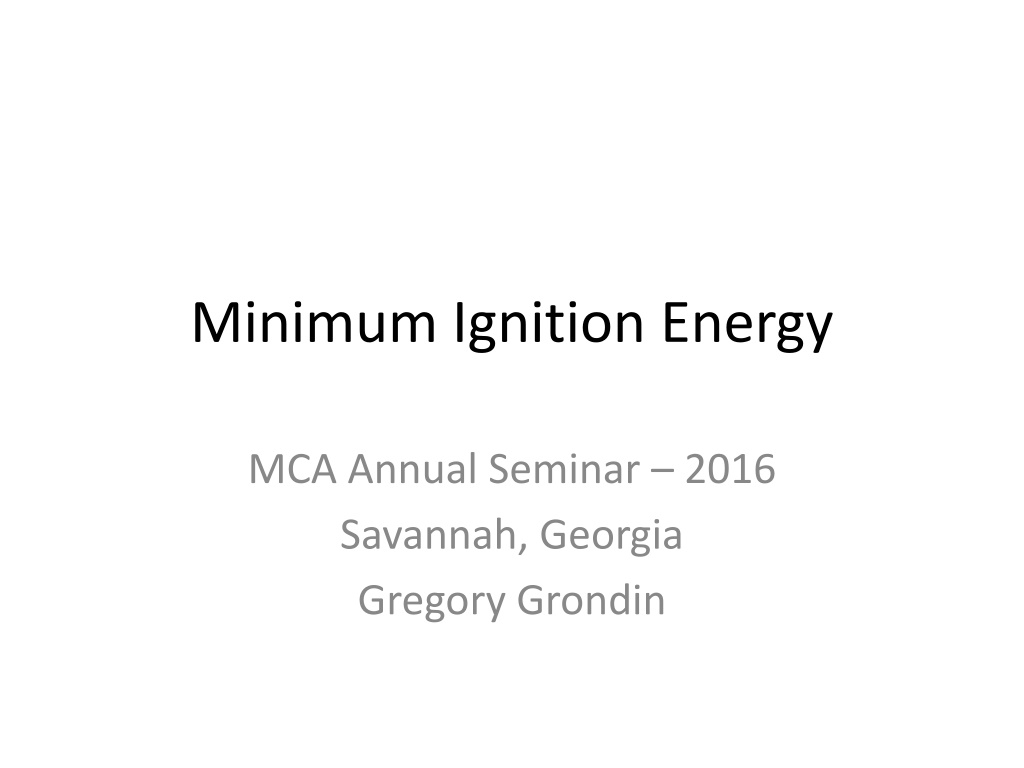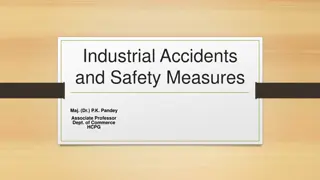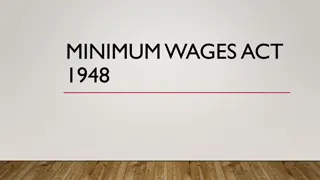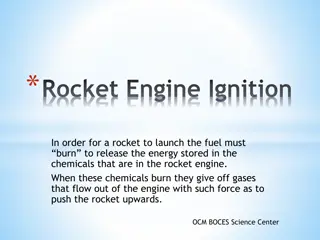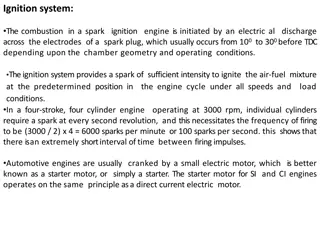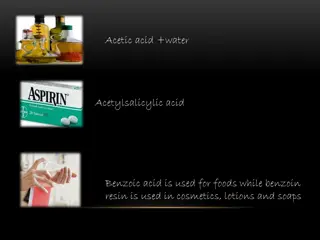Understanding Minimum Ignition Energy (MIE) in Industrial Safety
Delve into the fascinating history and definition of Minimum Ignition Energy (MIE), exploring its origins, research milestones, and the critical role of the ignition kernel. Learn how MIE is used to assess the minimum energy required to ignite flammable materials, ensuring safety in industrial settings. Discover insights on spark gaps, the Joule definition, and the crucial factors influencing ignition in hazardous environments.
Download Presentation

Please find below an Image/Link to download the presentation.
The content on the website is provided AS IS for your information and personal use only. It may not be sold, licensed, or shared on other websites without obtaining consent from the author. Download presentation by click this link. If you encounter any issues during the download, it is possible that the publisher has removed the file from their server.
E N D
Presentation Transcript
Minimum Ignition Energy MCA Annual Seminar 2016 Savannah, Georgia Gregory Grondin
History of MIE Origin of the research of MIE began in 1910 by the US Bureau of Mines. Bureau of Mines was founded by Congress to conduct research and collect information concerning every aspect of the mining trade. Primary focus was on methane Lewis and von Elbe are credited with the introduction of a test method to determine MIE
Lewis and von Elbe It is possible to pass small electric sparks through an explosive gas without producing ignition. When the spark energy is increased, a threshold energy is eventually obtained at which the spark becomes incendiary in the sense that a combustion waved propagates from the spark through the volume of gas This was the defining criteria for MIE and the understanding of ignition kernel formation
MIE Definition The minimum energy that can ignite a mixture of a flammable material mixed with air or oxygen, measured by a standard procedure The minimum energy of an ignition source, such as a spark, required to ignite vapors or dusts The minimum energy required to establish the flame kernel of the minimum critical size for subsequent self-sustained flame propagation
Ignition Kernel An electric spark establishes a small volume of hot gas immediately after spark discharge. The temperature within the flame kernel increases rapidly. As the kernel grows in size it is cooled by the ambient/adjacent unburned gas/vapor and the combustion wave dissipates Need adequate energy in the spark to generate a kernel of sufficient size for sustained combustion Need enough ions to sustain combustion Analogy flash point and fire point This energy is measured in millijoules (mJ)
Joule Definition It is the energy dissipated as heat when an electric current of one ampere passes through a resistance of one ohm for one second. Note that this energy source is electrical MIE rule of thumb for flammable vapors is .025mJ A small coin dropped from a height of less than 1 mm has more energy A spark that is detectable to the touch is about 20 mJ
Spark Gap/Quenching Distance Lewis and von Elbe understood that there were important variables when determining the MIE Spark Gap - Typically slightly greater distance than the quenching distance. If the spark gap is less than the quenching distance then the electrodes act as a heat sink for the flame kernel and cause inaccurate results. Quenching Distance - Minimum distance between electrodes which allows optimal ignition with minimal energy loss.
MIE Test Apparatus Fuel is vaporized, injected into test chamber so volume is in middle of flammable range and ignited using an electric arc Spark duration and energy are measured Chamber pressure rise will indicate a combustion reaction Very similar but smaller apparatus and theory to the 20L or 1 M3 test chamber that determines if dusts are combustible
Combustible Dust Test Chambers 20 L test results can be misleading - ST 1 dusts with Kst less than 50 can produce a false positive indication in a 20L test chamber - Test anomaly is called overdriving - Igniters cause the pressure increase, not the dust - Solution, use a 1M3 test chamber
MIE of Common Chemicals CHEMICAL MIE (mJ) CHEMICAL MIE (mJ) ACETONE 1.15 ALUMINUM 50 ACETYLENE .017 CHARCOAL 20 ACROLEIN .13 COAL 250 ACRYLONITRILE .16 CORN MEAL 40 BENZENE .2 MANGANESE 305 BUTANE .25 SUGAR 30 CS2 .009 TITANIUM 40 GASOLINE .8 WOOD BARK 40-60 HYDROGEN .011 ISOPROPANOL .65 KEROSENE 20 METHANE .28 DIESEL 20 PROPANE .25 PROPYLENE .28
Orders of Magnitude Explosives, hydrogen, unsaturated hydrocarbons, and alkanes in oxygen have the lowest MIE, from 1-100 micro J Alkanes in air, distillate fuels, and hybrid mixtures range from 0.1-20 milli J Combustible dusts range from .01-10 J Kerosene and diesel 20 mJ
Auto-ignition Temperature More common term for Marine Chemists which is not based on electrical energy The minimum temperature required to ignite a gas or vapor, in air, at atmospheric pressure, without a spark or flame being present
K47000 Apparatus Determines the lowest temperature at which the vapors of a liquid or solid chemical sample will self- ignite under prescribed laboratory conditions. The temperatures at which cool flame and hot flame ignitions occur, as evidenced by sudden temperature increases in the sample flask, are measured and recorded, and the delay time between introduction of the sample and ignition is timed.
Test Process Sample (100ul) introduced into a well insulated flask that is uniformly heated. Gas/vapor temp is monitored as heating is performed Cool flame temp is recorded slight blue flame, small but fast temp rise Instant significant temp rise indicates combustion hot flame temperature. Recorded as the auto-ignition temperature
Cool Flame A flame having maximal temperature below about 400 C (752 F). It is usually produced in a chemical reaction of a certain fuel-air mixture. Contrary to conventional flame, the reaction is not vigorous and releases very little heat, light and carbon dioxide. Incomplete combustion
Conclusions MIE and AIT are related in that they provide information about the energy required to ignite a chemical. An ignition source must have adequate energy to propagate combustion An electrical source of ignition is very small for most chemicals we deal with and is measured in mJ. Don t underestimate the power of electrical energy Other, more conventional ignition sources (hot work, light bulbs, heating coils) must be at or above the auto-ignition temperature of the chemical to propagate combustion
Lithium Ion Batteries If enough microscopic metallic particles converge on one spot, a sizable current begins to flow between the electrodes of the cell, and the spot heats up and weakens. As a small water leak in a faulty hydro dam can develop into a torrent and take a structure down, so too can heat buildup, damage the insulation layer in a cell and cause an electrical short. The temperature can quickly reach 500 C (932 F), at which point the cell catches fire or it explodes. This thermal runaway that occurs is known as venting with flame. Rapid disassembly is the preferred term by the battery industry.
Inspection Drone Are these guys at risk?
Controls In flight Quality pictures
Battery Operated Drones Should battery operated drones be considered potential ignition sources when used inside cargo tanks? Could the batteries or drones ignite residues inside the cargo tanks? Should the cargo tanks be cleaned to the extent that they are Safe For Hot Work or is a cleanliness level of Atmosphere Safe For Workers sufficient??
ASFW Level of Cleanliness Pros Permits the use of drones for inspecting cargo tanks without fully cleaning the tanks Reduces cost Enhances the safety of the inspection team by eliminating the fall potential Reduces the need for staging Cons Could be an ignition source
SFHW Level of Cleanliness Pros Eliminates the potential ignition of cargo residues Ensures total fire safety of the inspection team Cons No cost reduction in cleaning activity Staging required Fall potential for inspection team remains
MCA Action MCA is reviewing the use of drones to consider if they present a new potential ignition hazard in cargo tanks MCA recognizes the huge time/cost benefit to using drones to perform internal structural inspections in cargo tanks MCA is getting educated on the potential for batteries to be considered ignition sources for flammable atmospheres and residues
